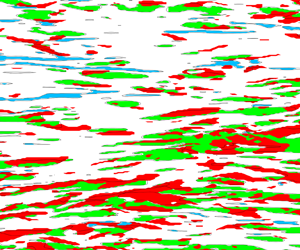No CrossRef data available.
Article contents
A critical analysis of turbulence dissipation in near-wall flows, based on stereo particle image velocimetry and direct numerical simulation data
Published online by Cambridge University Press: 13 October 2022
Abstract

An experiment was performed using stereo particle image velocimetry (SPIV) in the Laboratoire de Mécanique des Fluides de Lille boundary layer facility to determine all the derivative moments needed to estimate the average dissipation rate of the turbulence kinetic energy  $\epsilon = 2 \nu \langle {\mathsf{s}}_{ij}{\mathsf{s}}_{ij} \rangle$, where
$\epsilon = 2 \nu \langle {\mathsf{s}}_{ij}{\mathsf{s}}_{ij} \rangle$, where  ${\mathsf{s}}_{ij}$ is the fluctuating strain rate and
${\mathsf{s}}_{ij}$ is the fluctuating strain rate and  $\langle ~\rangle$ denotes ensemble averages. Also measured were all the moments of the full average deformation rate tensor, as well as all of the first, second and third fluctuating velocity moments except those involving pressure. The Reynolds number was
$\langle ~\rangle$ denotes ensemble averages. Also measured were all the moments of the full average deformation rate tensor, as well as all of the first, second and third fluctuating velocity moments except those involving pressure. The Reynolds number was  $Re_\theta = 7634$ or
$Re_\theta = 7634$ or  $Re_\tau = 2598$. The present paper gives the measured average dissipation,
$Re_\tau = 2598$. The present paper gives the measured average dissipation,  $\epsilon$ and the derivative moments comprising it. The results are compared with the earlier measurements of Balint, Wallace & Vukolavcevic (J. Fluid Mech., vol. 228, 1991, pp. 53–86) and Honkan & Andreopoulos (J. Fluid Mech., vol. 350, 1997, pp. 29–96) at lower Reynolds numbers and to new results from a plane channel flow DNS at comparable Reynolds number. Of special interest is the prediction by George & Castillo (Appl. Mech. Rev., vol. 50, 1997, pp. 689–729) and Wosnik, Castillo & George (J. Fluid Mech., vol. 421, 2000, pp. 115–145) that
$\epsilon$ and the derivative moments comprising it. The results are compared with the earlier measurements of Balint, Wallace & Vukolavcevic (J. Fluid Mech., vol. 228, 1991, pp. 53–86) and Honkan & Andreopoulos (J. Fluid Mech., vol. 350, 1997, pp. 29–96) at lower Reynolds numbers and to new results from a plane channel flow DNS at comparable Reynolds number. Of special interest is the prediction by George & Castillo (Appl. Mech. Rev., vol. 50, 1997, pp. 689–729) and Wosnik, Castillo & George (J. Fluid Mech., vol. 421, 2000, pp. 115–145) that  $\epsilon ^+ \propto {x_2^+}^{-1}$ for streamwise homogeneous flows and a nearly indistinguishable power law,
$\epsilon ^+ \propto {x_2^+}^{-1}$ for streamwise homogeneous flows and a nearly indistinguishable power law,  $\epsilon \propto {x_2^+}^{\gamma -1}$, for boundary layers. In spite of the modest Reynolds number, the predictions seem to be correct. Then the statistical character of the velocity derivatives is examined in detail, and a particular problem is identified with the breakdown of local homogeneity inside
$\epsilon \propto {x_2^+}^{\gamma -1}$, for boundary layers. In spite of the modest Reynolds number, the predictions seem to be correct. Then the statistical character of the velocity derivatives is examined in detail, and a particular problem is identified with the breakdown of local homogeneity inside  $x_2^+ = 100$. A more general alternative for partially homogeneous turbulence flows is offered which is consistent with the observations. With the help of DNS, the spatial characteristics of the dissipation very near the wall are also examined in detail.
$x_2^+ = 100$. A more general alternative for partially homogeneous turbulence flows is offered which is consistent with the observations. With the help of DNS, the spatial characteristics of the dissipation very near the wall are also examined in detail.
JFM classification
Information
- Type
- JFM Papers
- Information
- Copyright
- © The Author(s), 2022. Published by Cambridge University Press


